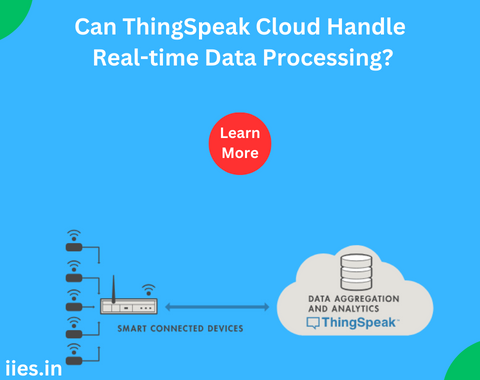
In the dynamic landscape of the Internet of Things (IoT), data acquisition, analysis, and visualization form the cornerstone of innovation. ThingSpeak, a powerful cloud platform, emerges as a pivotal tool in this ecosystem, enabling individuals and organizations to collect, analyze, and act upon real-time data streams. With its intuitive interface and robust features, ThingSpeak has become a cornerstone for IoT enthusiasts, researchers, and enterprises alike. In this article, we delve into the essence of ThingSpeak, exploring its capabilities, applications, and the transformative impact it brings to IoT development.
ThingSpeak, developed by MathWorks, stands as an open-source IoT platform that enables users to collect, analyze, and distribute data from sensors or actuators. At its core, ThingSpeak functions as a cloud-based IoT platform, offering a multitude of functionalities ranging from data collection to real-time visualization.
Launched in 2010, it has since evolved into a comprehensive solution for IoT applications, fostering innovation and experimentation across diverse domains.
Data Acquisition and Visualization:
One of the primary functionalities of ThingSpeak lies in its ability to gather data from various IoT devices and sensors. Through its simple Application Programming Interface (API), users can seamlessly upload data points to ThingSpeak channels, facilitating real-time monitoring and analysis. Additionally, ThingSpeak provides customizable visualizations, empowering users to create dynamic charts, graphs, and gauges to interpret data trends effectively.
Real-Time Data Processing:
ThingSpeak incorporates built-in MATLAB analytics capabilities, allowing users to perform complex data processing tasks directly within the platform. Leveraging MATLAB code integration, users can implement algorithms for data filtering, anomaly detection, and predictive analytics, enabling informed decision-making based on real-time insights.
IoT Integration and Interoperability:
ThingSpeak supports a wide array of IoT protocols and communication standards, fostering seamless integration with diverse hardware platforms and sensor devices. Whether utilizing MQTT, HTTP, or TCP/IP protocols, ThingSpeak offers flexibility and scalability, ensuring compatibility with a broad spectrum of IoT ecosystems.
Open-Source Customization:
One of the distinguishing features of ThingSpeak is its open-source nature, which encourages community collaboration and innovation. Users have the freedom to extend and customize ThingSpeak functionality according to their specific requirements, fostering a vibrant ecosystem of plugins, extensions, and integrations.
Environmental Monitoring:
ThingSpeak finds extensive applications in environmental monitoring and management, enabling users to track parameters such as temperature, humidity, air quality, and pollution levels in real-time. From smart agriculture to urban planning, ThingSpeak facilitates data-driven decision-making, fostering sustainability and resilience in diverse ecosystems.
Smart Infrastructure:
In the realm of smart cities and infrastructure, ThingSpeak plays a pivotal role in optimizing resource utilization, enhancing operational efficiency, and improving public services. By integrating sensor networks and IoT devices, municipalities can monitor traffic patterns, manage energy consumption, and mitigate environmental risks, thereby creating more livable and sustainable urban environments.
Industrial Automation:
In industrial automation and manufacturing, ThingSpeak serves as a cornerstone for process optimization, predictive maintenance, and quality control. By harnessing real-time data insights, enterprises can streamline production workflows, minimize downtime, and ensure product quality, thereby enhancing competitiveness and profitability in a dynamic market landscape.
Healthcare and Wellness:
ThingSpeak facilitates innovative solutions in healthcare and wellness, empowering practitioners and patients alike to monitor vital signs, track medication adherence, and manage chronic conditions remotely. Through wearable devices and IoT-enabled healthcare systems, ThingSpeak facilitates personalized care delivery, fostering improved patient outcomes and quality of life.
As IoT adoption continues to proliferate across industries, ThingSpeak stands poised to evolve and adapt to emerging trends and challenges. However, several considerations merit attention as the IoT landscape evolves:
Security and Privacy:
With the proliferation of connected devices and data streams, ensuring robust security and privacy measures remains paramount. ThingSpeak must continue to prioritize data encryption, access control, and threat detection mechanisms to safeguard sensitive information and preserve user trust.
Scalability and Performance:
As IoT deployments scale in complexity and scope, ThingSpeak must demonstrate scalability and performance to accommodate growing data volumes and user demands. Optimal resource allocation, load balancing, and system optimization are essential to ensure seamless operation and responsiveness.
Interoperability and Standards:
The interoperability of IoT devices and platforms remains a critical challenge, necessitating standardized protocols and communication frameworks. ThingSpeak should continue to support industry standards and open-source initiatives to foster compatibility and interoperability across heterogeneous IoT ecosystems.
Predictive Maintenance:
ThingSpeak’s integration with advanced analytics and machine learning algorithms enables predictive maintenance in industrial settings. By analyzing historical data patterns and sensor readings, enterprises can anticipate equipment failures, schedule maintenance proactively, and optimize asset lifecycle management. Predictive maintenance not only minimizes downtime and maintenance costs but also enhances operational efficiency and reliability across manufacturing and infrastructure sectors.
Anomaly Detection:
ThingSpeak’s robust analytics capabilities facilitate anomaly detection in diverse IoT applications. By applying statistical techniques and machine learning algorithms, users can identify deviations from expected behavior in sensor data streams, signaling potential anomalies or irregularities. Anomaly detection holds profound implications across domains such as cybersecurity, industrial safety, and healthcare monitoring, enabling proactive risk mitigation and incident response.
Edge Analytics:
ThingSpeak’s support for edge computing enables data processing and analysis at the network edge, closer to the data source. By deploying lightweight analytics modules on edge devices, users can reduce latency, conserve bandwidth, and extract actionable insights in real-time. Edge analytics empowers IoT deployments with greater autonomy, responsiveness, and resilience, facilitating distributed decision-making and adaptive control in dynamic environments.
In conclusion, ThingSpeak stands as a transformative force in the realm of IoT, empowering individuals and organizations to harness the power of data for innovation and progress. With its intuitive interface, robust features, and open-source ethos, ThingSpeak facilitates seamless data acquisition, analysis, and visualization, fostering actionable insights and informed decision-making across diverse domains. As IoT continues to redefine the contours of technology and society, ThingSpeak remains at the forefront of this paradigm shift, driving forward the boundaries of innovation and possibility.
Indian Institute of Embedded Systems – IIES